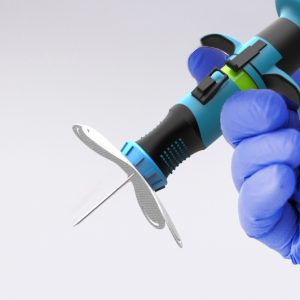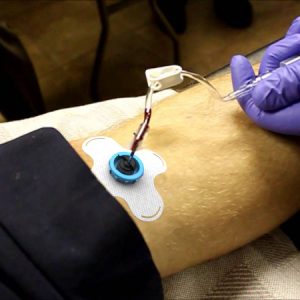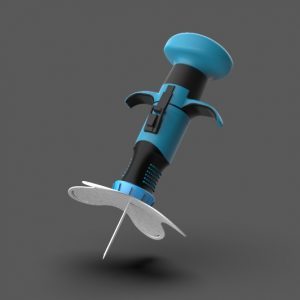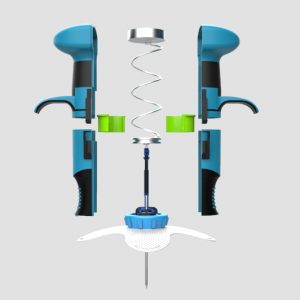Product Name: Opt IO
Topic/problem description:
In disaster relief, emergency response, and in combat, when someone receives a fatal injury or any high amount of blood loss, they need pressurized IV fluids to stay alive. The product that is used to start this line is called an Intraosseous (IO) device. An IO is a bone needle used to go into thicker parts of the human bone to start a fluid line that is more direct to the heart. The reason combat medics don’t use standard IV lines is that veins retract when people go into shock, and it’s not the fastest path to the heart. IO devices are currently not as effective as they could potentially be. They often fail because if they aren’t placed at the proper angle, they run the risk of fracturing the bone and not getting the IV solution into the bloodstream. IO devices need to be small and easily stored, but current solutions have prioritized this design property over more crucial ones, like how the nurse stabilizes the device before insertion. Also, many IO devices used in the field require human force to puncture the bone. This causes a much higher risk of the needle slipping out of the proper angle and is a very uncomfortable feeling for the nurse. Most current IO products used in the field don’t have appropriate means of sanitizing the needle or insertion site or require different length needles to function correctly. Many military and emergency response products also have requirements for their products; they prefer products that are durable, lightweight, with no electronics, and easily stored. There needs to be a more effective and user-centered approach to the IO device so that combat medics and emergency response nurses will be able to start patient IV lines faster, ultimately saving more lives.
Solution:
My solution is Opt IO. Opt IO is an IO device that responds to all of the problems I discovered through my user research, that adapts to all insertion points, and is a combination of all the other IO products benefits. I realized that in order to create a product that was lightweight and portable while still being able to be correctly stabilized and understood by a nurse, I would have to take inspiration from their current products. By having the IO be held and used similar to a syringe, it will be a familiar form that nurses are used to stabilizing. Also, the finger grip at the bottom will allow the nurse to put a finger on each side while using the rest of their hand to stabilize it against the body. This way, the nurse will be maintaining the proper angle while activating the spring mechanism. The spring allows for a quick and already calculated amount of pressure that will be not only faster but safer for the patient rather than the current methods of using human force to push the needle. This way, all of the nurse’s attention can be on maintaining the proper angle and insertion site rather than maintaining the appropriate pressure. All of the IV tubings are housed within the one time use IO device, ensuring that it is sanitary for each patient. After the needle is inserted, the medical professional unscrews the bottom end and pulls the rest of the device and inner needle out of the patient. By having all the tubing ready to go immediately after inserting the needle, the overall time of administering IV fluid is increased dramatically. By having an IO device that is as easy to understand as possible, this will ultimately save many lives globally.





